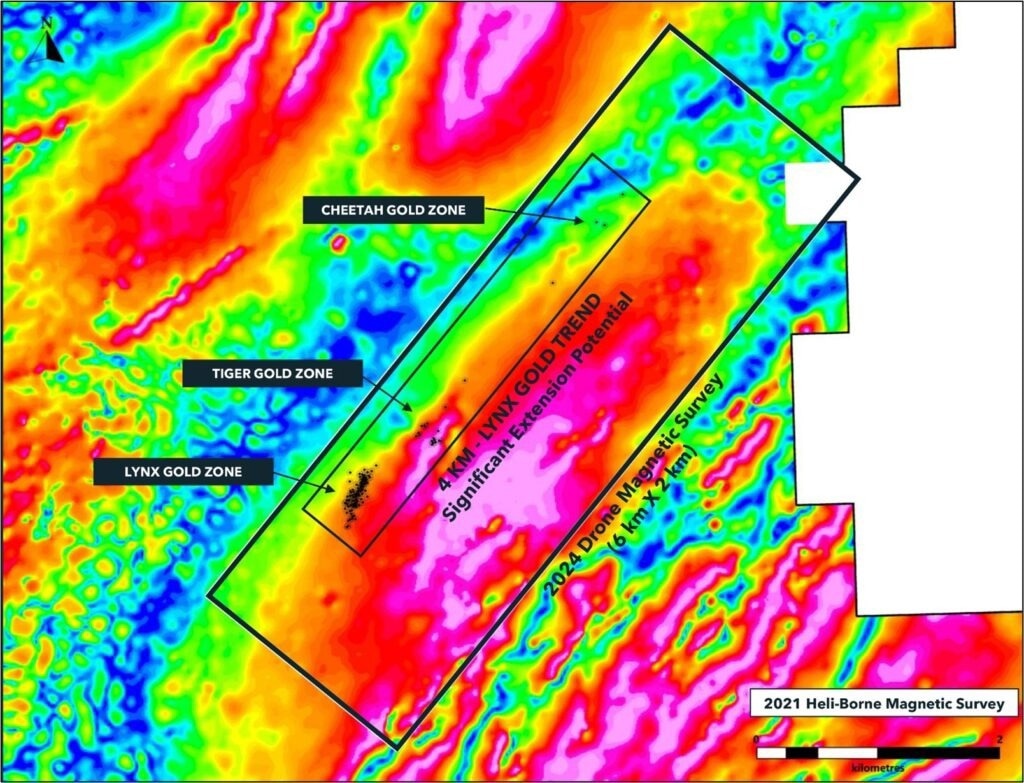Reviewed by Lexie CornerApr 26 2024
A high-resolution magnetic survey has been initiated at Puma Exploration Inc.'s Williams Brook property in Northern New Brunswick. Drilling has confirmed a favorable prospective gold corridor, and the drone survey will cover a distance of 6 km along the Lynx Gold Trend and a width of 2 km.
 Location of the drone magnetic survey over the Williams Brook Property. Image Credit: Puma Exploration Inc.
Location of the drone magnetic survey over the Williams Brook Property. Image Credit: Puma Exploration Inc.
A survey covering an area of approximately 12 km2, consisting of 372 line km spaced 35 m apart, has been contracted out to Vision 4k Inc. The Lynx Gold Zone's lithology and structural characteristics that govern gold mineralization will be mapped with the aid of the survey, and the data mapped will be translated into the Lynx Gold Trend. Further exploration and drilling targets will be identified by the thorough overprint of lithological contacts and additional structural features along the Lynx Gold Trend.
Our 2024 exploration strategy is to focus on the Lynx Gold Trend. Our work at the Lynx Gold Zone has shown that high-grade gold occurs at the contact between two rock types. The survey will help us identify this contact along the newly identified extension of the Lynx Gold Trend, where very little work has been done so far but where our percent drilling has shown promise. This very low-cost exploration tool will help direct our summer trenching and stripping program in preparation for our next round of drilling.
Marcel Robillard, President and CEO, Puma Exploration Inc.
Ongoing Exploration at the Williams Brook Gold Project
- Beginning in May, surface exploration will involve a program of sampling and stripping along the advantageous 4 km corridor. This will contribute to the success of the drilling process, enhancing and extending the Lynx Gold Deposit.
- The results of the 2023 drilling at the LGZ, both along strike and at depth, are almost fully integrated into the 3D model of the mineralization of the Lynx Gold Zone. For upcoming drilling to the updated model, Puma will have more high-grade drilling targets at the LGZ.
- Beginning in May, surface exploration will involve a program of sampling and stripping along the advantageous 4 km corridor. This will contribute to the success of the drilling process, enhancing and extending the Lynx Gold Deposit.
- Puma is still working on the Williams Brook Gold Project, reducing risk. Metallurgical work was done last year to identify and address any problems with gold recoveries. A 3-ton bulk sample was used for a small-scale simulation this past winter. The outcomes are promising, and soon, a thorough evaluation of the finished project will be conducted.
About the Williams Brook Gold Project
Puma’s premier Williams Brook Gold Project encompasses four properties spanning over 50,000 hectares in Northern New Brunswick. It is situated in a well-established and mining-friendly jurisdiction with convenient access to paved roads and top-notch infrastructure. This expansive land package is positioned near the Rocky Brook Millstream Fault (“RBMF”), a prominent regional structure forged during the Appalachian Orogeny, serving as a pivotal factor in gold deposition within the area.
Puma's exploration endeavors have yielded notable results, including 5.50 g/t gold over 50.15 m in hole WB21-02, 2.77 g/t gold over 42.80 m in hole WB22-66, 2.49 g/t gold over 63.05 m in WB23-139, 5.15 g/t gold over 23.15 m in WB23-142, and 1.24 g/t gold over 98.05 m in WB23-145.
Since 2021, with an exploration investment of less than C$15 million, Puma has achieved numerous gold discoveries at the Williams Brook property, indicating the presence of a substantial orogenic gold system. Puma remains dedicated to its ongoing exploration programs to establish a gold camp in Northern New Brunswick, Canada.
Dr. Gregg Morrison, a leading expert on intrusion-related, porphyry, and epithermal gold systems, noted: “I believe Williams Brook is part of the same family of gold systems as Fosterville and Sunday Creek in Australia and Valentine Lake in Newfoundland. These other deposits are known for their structure-controlled mineralization, metal zoning, free gold in bonanza shoots, and kilometer-scale depth extent. The similarities to these more comprehensively explored deposits gives real confidence to deeper drilling in the Lynx Zone and continued exploration around the feeder structures in the Williams Brook District.”